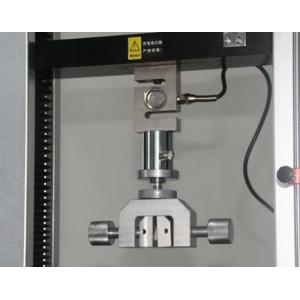tensile test procedure
Add to Cart
tensile test procedure
tensile strength tester machine are suitable for tensile,
compression and all other special load test for metal and non metal
material. This universal testing machine can test plastic, rubber,
thread, wood, alloy, PVC, spring, electrical wire and cable,
composite, profiled bar, waterproof roll, etc. Add relative
optional accessories, this universal testing machine is easy to
achieve the test of bending, shearing, peeling, friction, tearing,
puncture and hardness test.
Tensile Test Experiment
One material property that is widely used and recognized is the strength of a material. But what does the word "strength" mean? "Strength" can have many meanings, so let us take a closer look at what is meant by the strength of a material. We will look at a very easy experiment that provides lots of information about the strength or the mechanical behavior of a material, called the tensile test.
The basic idea of a tensile test is to place a sample of a material between two fixtures called "grips" which clamp the material. The material has known dimensions, like length and cross-sectional area. We then begin to apply weight to the material gripped at one end while the other end is fixed. We keep increasing the weight (often called the load or force) while at the same time measuring the change in length of the sample.
One can do a very simplified test at home.
If you have a way to hang one end of some material from a solid
point that does not move, then you can hang weights on the other
end.
Measure the change in length while adding weight until the part
begins to stretch and finally breaks.
The result of this test is a graph of load (amount of weight)
versus displacement (amount it stretched). Since the amount of
weight needed to stretch the material depends on the size of the
material (and of course the properties of the material), comparison
between materials can be very challenging. The ability to make a
proper comparison can be very important to someone designing for
structural applications where the material must withstand certain
forces.
We need a way of directly being able to compare different
materials, making the “strength” we report independent of the size
of the material. We can do that by simply dividing the load applied
to the material (the weight or force) by the initial
cross-sectional area. We also divide the amount it moves
(displacement) by the initial length of the material. This creates
what material scientists refer to as engineering stress (load
divided by the initial cross-sectional area) and engineering strain
(displacement divided by initial length). By looking at the
engineering stress-strain response of a material we can compare the
strength of different materials, independently of their sizes.
To use the stress-strain response for designing structures, we can
divide the load we want by the engineering stress to determine the
cross-sectional area needed to be able to hold that load. For
example, a 1/8” diameter 4340 steel wire can hold a small car.
Again, it is not always that simple. We need to understand the
different meanings of “strength” or engineering stress.
Now it gets more complicated. Let us take a look at what is meant
by the different strength values and also look at other important
properties we can get from this simple test. The easiest way is to
examine a graph of engineering stress versus engineering strain.
Shown below is a graph of a tensile test for a common steel
threaded rod, providing a good example of a general metal tensile
test. The units of engineering stress are ksi, which stands for a
thousand pounds per square inch. Note the reference to area in the
units. The units on strain are of course unitless, since we are
dividing distance by distance.
Three Star Service :
*First Star---Pre-service
24 Hours online service for your consult
Help choose right model,and a series of service,person,advise.
*Second Star---Middle Service
--Give you best offer
--Provide discount for many sets order
--Do customer's request
--Choose payment term you convienent.
--Promptly production and delivery,inform you in time.
--Can provide invoice value as you like to decrease your tax.
. *Third Star---After serivce
--1 year warranty service and all life maintenance.
--Technical Egineer are avalible for oversea trainning.
--Free change for some parts
--Provide newest software vision when update
--Remote control technical consult
--Free installation DVD
--Maintenance plan
tensile strength test sample dimensions is difference for difference test job .More detail information about the tensile strength test sample dimensions,please kindly contact with me .



